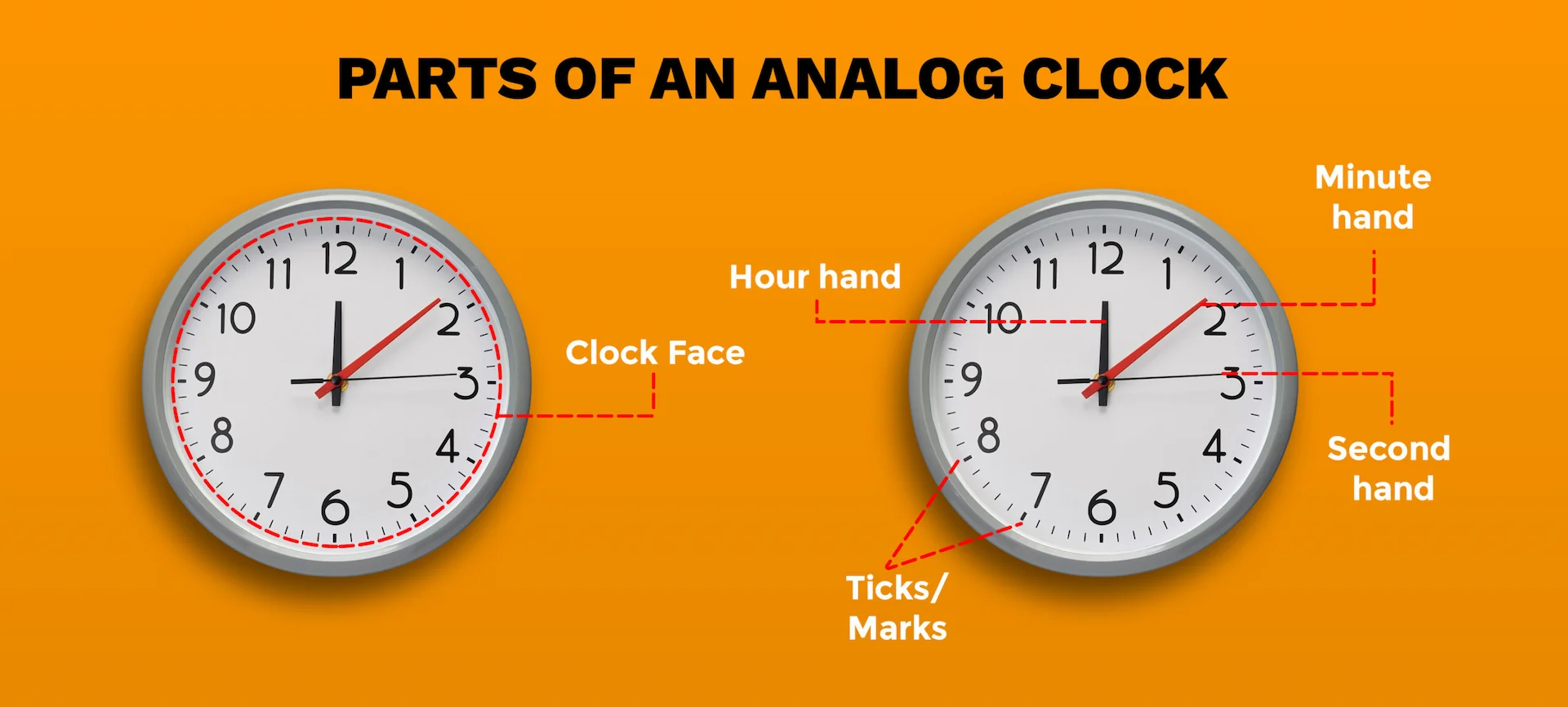Learning to tell time in English is a must-have skill for daily conversations, especially for those starting their journey with English for beginners. Whether you’re catching a bus, meeting a friend, or scheduling your day, this guide makes time-telling simple, fun, and practical.
Designed to match the concept of English for beginners, this post is teaching you key ideas and encouraging you to practice and apply what you learn. Let’s dive in and master telling time in English!
Why Learn to Tell Time in English?
Time is everywhere in daily life. Imagine you’re rushing to catch a train, planning a coffee date, or checking when your favorite store opens. Knowing how to ask and tell time in English helps you navigate these moments with confidence. This guide is perfect for beginners because it breaks down the basics into easy steps, making time-telling approachable and useful.
Take Action: Try asking a friend, “What’s the time?” today and see how it feels to use English in real life!

Numbers You Need for Time-Telling
To tell time, you need to know numbers from 1 to 60 for hours and minutes. Don’t worry—this is easier than it sounds.
A. Basic Numbers
1-10: one, two, three, four, five, six, seven, eight, nine, ten
11-20: eleven, twelve, thirteen, fourteen, fifteen, sixteen, seventeen, eighteen, nineteen, twenty
Tens: twenty, thirty, forty, fifty
B. Higher Numbers
For minutes, combine numbers like:
20-29: twenty-one, twenty-two, …, twenty-nine
30-59: thirty, thirty-one, …, fifty-nine
Tip for Beginners: Say numbers out loud to practice pronunciation. For example, say “twenty-five” or “forty-two” while looking at a clock. This builds confidence for English for beginners.
Practice Now: Write down numbers 1-20 and say them aloud. Then, try counting by tens (ten, twenty, thirty) to feel natural.

How to Tell Time in English
Telling time in English is simple once you know the patterns. Here’s how to do it:
Exact Hour: Use “o’clock.”
Example: 1:00 is “one o’clock.”
Minutes Past the Hour: Use “past.”
Example: 2:15 is “a quarter past two” or “two fifteen.”
Minutes to the Next Hour: Use “to.”
Example: 2:45 is “a quarter to three” or “two forty-five.”
Half Past: For 30 minutes.
Example: 2:30 is “half past two.”
Digital Time: Just say the numbers.
Examples:
5:20 is “five twenty.”
3:00 – “Three o’clock”
4:15 – “A quarter past four” or “four fifteen”
5:30 – “Half past five”
6:45 – “A quarter to seven” or “six forty-five”
Try It: Look at your phone or clock right now. What time is it? Say it in English using “past” or “to.” For example, if it’s 9:10, say “ten past nine.”

Understanding the Clock
For beginners, analog clocks (with hands) are common in homes, schools, and watches. Here’s what you need to know:
Clock Face: The round part with numbers 1 to 12.
Hour Hand: The short hand points to the hour.
Minute Hand: The long hand points to the minutes (each mark = 1 minute).
Second Hand: The long, thin hand that moves the fastest among the three hands. It makes a full rotation every 60 seconds, ticking or sweeping over each second mark on the clock face (each tick = 1 second).
Ticks/Marks: The lines between numbers show minutes. For example, 5 marks = 5 minutes.
Example: If the hour hand is on 4 and the minute hand is on 6, it’s 4:30 (since 6 × 5 = 30 minutes). Say, “It’s half past four.”
Action Step: Find an analog clock (on your watch or wall). Name the parts (hour hand, minute hand) in English to practice English for beginners vocabulary.

Common Time Phrases for Everyday Use
These phrases are easy and perfect to English for beginners to use in real-life situations like meeting friends, checking schedules, or planning your day. Mastering these will help you sound natural and confident in conversations:
1. What’s the time? — A simple way to ask for the time.
Example: “What’s the time? I need to catch my bus.”
Why Use It: This is the most common question to ask about time, perfect for beginners in everyday settings like school or work.
2. It’s about… — For approximate time when you’re not sure of the exact minute.
Example: “It’s about six o’clock. Let’s have dinner.”
3. Ten past… — For minutes after the hour.
Example: “It’s ten past two. The store is open.”
4. Five to… — For minutes before the next hour.
Example: “It’s five to seven. Hurry up for the movie!”
5. A quarter past… — For 15 minutes past the hour.
Example: “It’s a quarter past one. Let’s go to the park.”
6. A quarter to… — For 15 minutes before the next hour.
Example: “It’s a quarter to eight. We need to leave soon.”
7. Half past… — For 30 minutes past the hour.
Example: “It’s half past three. Time for a coffee break.”
8. On the dot – For exact time, emphasizing punctuality.
Example: “Be here at two on the dot for the meeting.”
9. Running late – When you’re behind schedule.
Example: “It’s ten past six, and I’m running late for dinner.”
10. Just after… — For shortly after the hour.
Example: “It’s just after six. The bus is coming soon.”
11. Right on… — Another way to say exact time.
Example: “It’s right on seven o’clock. The show starts now.”
Practice Challenge: Use at least three of these phrases today. For example, ask “What’s the time?”, say “It’s a quarter past…” when checking the time, and use “on the dot” when planning something. Write down what you said and how it felt to use English in real life.

Fun Ways to Practice Telling Time
Learning to tell time is easier with practice. Here are tips for English for beginners to make it fun:
1. Use a Clock App: Download an app showing analog or digital time. Practice saying the time hourly.
Example: At 2:15, say, “It’s a quarter past two.”
2. Practice with Friends: Ask a friend to show you a time on their phone or clock. Say it in English.
Example: If they show 7:45, say, “It’s a quarter to eight.”
3. Watch English Shows: Listen for time phrases in movies or TV shows. Repeat them to sound natural.
Example: Hear “Meet me at ten” and say it aloud.
4. Make a Schedule: Write your daily routine in English with times. Say them out loud.
Example: “I wake up at seven o’clock. I eat lunch at half past twelve.”
5. Use Flashcards: Write times (e.g., 3:30) on one side and phrases (e.g., “half past three”) on the other. Test yourself daily.
Action Step: Pick one tip and try it today. For example, write your schedule in English and read it aloud.

Simple Dialogues to Practice
Practice these dialogues to feel confident in English for beginners conversations. Each includes a scenario to make them relatable and a practice tip to apply what you learn:
Asking for the Time at a Bus Stop
A: Excuse me, do you have the time?
B: Sure, it’s a quarter past three.
A: Thanks! I hope the bus comes soon.
Scenario: You’re at a bus stop and need to know if you’re on time. Asking for the time is a great way to start a conversation in English.
Try It: Ask someone for the time today, like at a store or school. Write down their answer in English to practice.
Making Plans for a Study Group
A: Hey, when should we meet to study?
B: How about half past five at the library?
A: Sounds good! I’ll be there on the dot.
Scenario: You’re planning a study session with classmates. Using time phrases helps you sound clear and organized.
Try It: Plan a meet-up with a friend using English time phrases. For example, say, “Let’s meet at a quarter to six.”
Discussing a Movie Schedule
A: What time does the movie start?
B: It’s at a quarter to eight.
A: Okay, let’s meet ten minutes before.
Scenario: You’re planning to watch a movie with friends. Knowing the exact time helps you arrive prepared.
Try It: Check the time of an event (like a movie or show) and discuss it in English with someone.
Checking Store Hours
A: Excuse me, what time does the store open?
B: It opens at nine o’clock.
A: Thanks! I’ll come back just after nine.
Scenario: You’re shopping and need to know store hours. This is a practical way to use time phrases in everyday life.
Try It: Ask about the opening or closing time of a place, like a café or shop, in English.

Your 3-Day Time-Telling Challenge
Ready to take your English skills to the next level? Try this challenge:
Day 1: Ask someone, “What’s the time?” and write down their answer in English.
Day 2: Tell someone the time in English. For example, “It’s ten past four.”
Day 3: Plan a meeting or activity with a friend using time phrases like “Let’s meet at a quarter past six.”
Share your progress with a friend or teacher to stay motivated!
Conclusion
Mastering how to ask and tell time in English is easier than you think. This guide for English for beginners covers numbers, phrases, and practical tips to help you speak confidently. Practice daily with clocks, friends, or shows, and try the 3-day challenge to see quick progress. Start today, and soon you’ll be telling time like a pro!
Key Points:
- Learn numbers 1-60 for hours and minutes.
- Use phrases like “o’clock,” “past,” “to,” “quarter,” and “half.”
- Practice with dialogues and real-life situations.
- Try fun tips to make English for beginners time-telling exciting.
Ready to level up your English? Discover our beginner-friendly courses at EnglishFact to build confidence and fluency. Got questions? Reach out via WhatsApp or sign up today!




